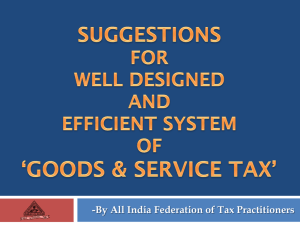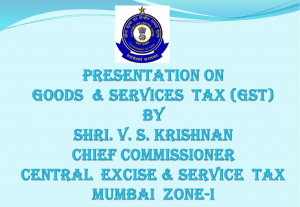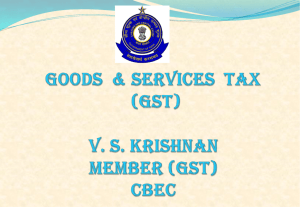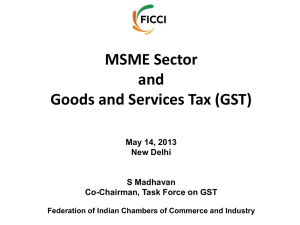a brief on gst bill
advertisement
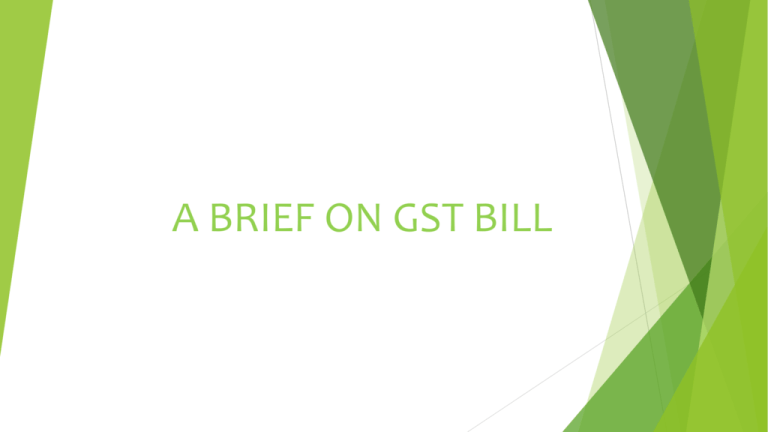
A BRIEF ON GST BILL Historical background GST was first recommended by Kelkar Task Force on implementation of Fiscal Reforms and Budget Management Act 2004 but the First Discussion Paper on Goods and Services Tax in India was presented by the Empowered Committee of State Finance Ministers dtd.10th Nov.10th, 2009. In 2011, the Constitution (115th Amendment) Bill, 2011 was introduced in Parliament to enable the levy of GST. However, the Bill lapsed with the dissolution of the 15th Lok Sabha. Subsequently, in December 2014, the Constitution (122nd Amendment) Bill, 2014 was introduced in Lok Sabha. The Bill was passed by Lok Sabha in May 2015 and referred to a Select Committee of Rajya Sabha for examination. Definition “GST is a tax on goods and services with value addition at each stage having comprehensive and continuous chain of set of benefits from the producer’s / service provider’s point up to the retailers level where only the final consumer should bear the tax.” OBJECTIVE One Country - One Tax Consumption based tax instead of Manufacturing Uniform registration, payment and Input Credit To eliminate the cascading effect of Indirect taxes on single transaction Subsume all indirect taxes at Centre and State Level under Reduce tax evasion and corruption Increase productivity Increase Tax to GDP Ratio and revenue surplus Increase Compliance Reducing economic distortions Regulatory Framework A new set up by Government of India named as ‘GST Council’. The GST Council consists of (a) the Union Finance Minister (as Chairman), (b) (b) the Union Minister of State in charge of Revenue or Finance, and (c) (c) the Minister in charge of Finance or Taxation or any other Minister, nominated by each state government. All decisions of the GST Council will be made by three fourth majority of the votes cast; the centre shall have one-third of the votes cast, and the states together shall have two-third of the votes cast. Action Plan of GST Council List number of Taxes, cesses, and surcharges to be subsumed under GST Preparation of list of goods and services subject to, or exempt from GST Determination of threshold limit of turnover for application of GST Fixation of rates Preparation of model GST Laws, principles of levy, apportionment of tax benefits Firming up Place of supply Rules Recommend on Compensation to states losing on revenue post implementation of GST, subject to maximum time limit of 5 years. SCOPE OF GST All goods and services are covered under GST Regime except Alcoholic liquor for Human Consumption, Tobacco Products subject to levy of GST and Centre may also levy excise duty GST Council yet to decide the incidence and levy of GST on following; a) Crude Petroleum b) High Speed Diesel (HSD) c) Motor Spirit (Petrol) d) Natural Gas e) Aviation Turbine Fuel Key changes between the current Tax Structure and proposed GST Regime SL. Particulars Current Scenario GST Scenario 1) Structural Difference a) Central Taxes:-Central Excise/Custom Duty, Central Sales Tax on Goods and Service Tax charged on Services, Surcharge & Cess b) State Taxes-State Vat, Sales Tax Deducted at Source, WCT, Luxury Tax, Entertainment Tax, Tax on Lottery, Surcharge & Cess A dual layered tax system with both Central and State GST levied on same base on all the goods and services except Petroleum ,High Speed Diesel, Motor spirit and Natural Gas to be brought at a later date, subject to recommendation of GST Council. 2) Basis of Levy Taxable at the place of a) Manufacture/Sale of goods, b) Rendering of services Taxable at the place of Consumption, a destination based tax SL. Particulars Current Scenario GST Scenario 3) Registration Decentralised registration under Central and State Authorities Uniform E-Registration process based on PAN of Entity 4) Procedures for Collection of Tax and Filing of Returns Central Excise and Service Tax-Uniform, VAT-Varies from State to State and Uniform process and common dates for collection/deposit of tax and filing of returns 5) Validation and of Challan/ Returns, Input Credit and Payment of Tax Part validation by system, full verification subject to assessments by relevant Central/State authorities System based validation and consistency checks on Input Credit availed, utilisation and Tax Payments SL. Particulars Current Scenario GST Scenario 5) Excise Duty Excise Duty charged up to the point of Manufacturing Replaced by CGST (Central Goods and Service Tax, to be charged up to Retail Level 6) Basic Customs Duty In case of Import, taxed by Centre under separate act No Change 7) Countervailing Duty/Special Additional Duty In case of Import, taxed by Centre, separately To be subsumed under GST (CGST) 8) Service Tax Charged by Centre on list of Services under Finance Act on Payment/Provision Basis To be subsumed under SGST (State Goods and Service Tax), based upon Place of Supply Rules SL. Particulars Current Scenario GST Scenario 9) Central Sales Tax (CST) Applicable at concessional rate of 2% on inter-state transfers against C-Forms, otherwise full rate i.e. 5% to 14.5% To be subsumed in IGST (Integrated Goods and Service Tax) 10) State VAT Except exempt items, all goods are taxed Subsumed in SGST (State Goods and Service Tax) 11) Entry Tax Currently being charged by selected states for interstate transfers, held as import in local area No entry tax, Additional 1% of Tax to be levied on interstate supply of selected goods, list yet to be finalised 12) Tax on Export of Goods and Services Exempt/Zero rated No Change SL. Particulars Current Scenario 13) Tax on Inter Exempt against Form F State Transfer of Goods to Branch or Agent To be taxable but full credit available to dealers 14) Tax on Transfer Generally Exempt; Depends of Goods to Upon State Procedures Branch or Agent within State Might Be taxable , Unless TIN of Transferor and Transferee is same 15) Cascading Effect Credit available on the full amount of taxes up to retailer 16) Cross Set-Off of Currently set-off of Excise Levy duty and Service tax is allowed Credit between Excise Duty & Service Tax available, but no set-off against VAT on Excise Duty GST Scenario No cross Set-off between CGST and SGST SL. Particulars Current Scenario GST Scenario 17) Cascading Effect Credit between Excise Duty & Service Tax available, but no set-off against VAT on Excise Duty Credit available on the full amount of taxes up to retailer 18) Disallowance of Credit on selected items There are certain nonNo such disallowance, unless creditable goods and services specified by GST Council under both VAT & CENVAT Rules 19) Disallowance of Not Allowed inputs/input services used in Exempted Goods /Services No such disallowance, unless falling under the Negative List which is yet to be finalised by GST Council SL. Particulars Current Scenario GST Scenario 20) Exemptions – Excise Free Zone, VAT Remissions Some areas enjoy status of Excise/Vat Exemptions i.e. North East, Himachal No such Exemptions, Investment Refund Scheme (IRS) may be introduced for existing zones based upon recommendations of GST Council 21) Levy of Tax on Government Bodies, NGOs Certain Govt. bodies, PSUs and Non-for-profit bodies covered Not Changed 22) Threshold Limits for levy of Tax a) Central Excise-1.5 Crores b) VAT-Varies from Rs. 5 to 20 Lacs from state to state c) Service Tax- Rs.10 Lacs CGST-Limits to be decided SGST-Rs.10 Lacs to 20 Lacs as recommended by GST Council SL. Particulars Current Scenario GST Scenario 23) Exemptions – Excise Free Zone, VAT Remissions Some areas enjoy status of Excise/Vat Exemptions i.e. North East, Himachal No such Exemptions, Investment Refund Scheme (IRS) may be introduced for existing zones based upon recommendations of GST Council 24) Levy of Tax on Government Bodies, NGOs Certain Govt. bodies, PSUs and Non-for-profit bodies covered Not Changed 25) Threshold Limits for levy of Tax a) Central Excise-1.5 Crores b) VAT-Varies from Rs. 5 to 20 Lacs from state to state c) Service Tax- Rs.10 Lacs CGST-Limits to be decided SGST-Rs.10 Lacs to 20 Lacs as recommended by GST Council Tax layers under proposed GST Model It is a Dual-GST structure proposal wherein the Central Government and State Government will simultaneously charge GST on the same economic supply Inter-state transactions or supplies to be charged an Integrated GST (IGST) which is a combination of Central-GST (CGST) and State-GST (SGST) rates Unique input tax credit mechanism; as illustrated below: CGST Credits SGST Credits of State A IGST Credits CGST Liability SGST Liability of State A IGST Liability OR CGST Liability OR SGST Liability of State A Comparative Analysis (Intra-State Trade) (Assumed Rates for Excise Duty, CGST & SGST @12%, VAT @12.5%) Transaction Current Scenario (Amt. in Rs.) GST Scenario (Amt. in Rs.) Cost of Raw Materials to Input Manufacturer Profit Margin @ 25% Assessable Value Add: Excise Duty @12% I CGST @ 12% Add: VAT@12.5% I SGST@12% Invoice Value (Input Manufacturer to Output Manufacturer) Cost of Goods to Output Manufacturer (Net of ITC) Add: Value Addition @ 40% on Cost (incl. of Profit Margin) Assessable Value (Manufacturer to Wholesaler) Add: Excise Duty @12% I CGST @ 12% Add: VAT@12.5% I SGST@12% Invoice Value (Manufacturer to Wholesaler) Cost of Goods to Wholesaler (Net of ITC) Add: Profit Margin of Wholesaler @10% Add: Excise Duty @12% I CGST @ 12% Add: VAT@12.5% I SGST@12% 100 25 125 15 18 158 100 40 140 16.80 19.60 176.40 156.80 15.68 0.00 100 25 125 15 15 155 100 40 140 16.80 16.80 173.60 140.00 14.00 18.48 21.56 Invoice Value (Wholesaler to Retailer) 194.04 Cost of Goods to Retailer (Net of ITC) 172.48 Add: Profit Margin of Retailer @10% 17.25 Add: Excise Duty @12% I CGST @ 12% 0.00 Add: VAT@12.5% I SGST@12% 23.72 Final Price to be paid by Consumer 213.44 Cost Saving to Consumer 18.48 190.96 154.00 15.40 20.33 20.33 210.06 3.39 Comparative Analysis (Inter-State Trade) (Assumed Rates for Excise Duty, CGST & SGST @12%, CST @ 2% each) Transaction Current Scenario (Amt. in Rs.) Cost of Raw Materials to Input Manufacturer 90 Profit Margin Rs.10 10 Assessable Value 100 Add: Excise Duty @12% I CGST @ 12% 12 Add: Vat 12.5% I SGST@12% 14 Invoice Value (Input to Output Manufacturer) 126.00 Cost of Goods to Output Manufacturer (Net of ITC) 100 40 Add: Value Addition @ 40% on Cost (incl. of Profit Margin) Assessable Value (Manufacturer to Wholesaler) 140 Add: Excise Duty @12% I CGST @ 12% 16.80 Add: CST@2% I IGST@24% 3.14 Add: Additional Tax @1% 0 Invoice Value (Manufacturer to Wholesaler) 159.94 Cost of Goods to Wholesaler (Net of Input Credit) 159.94 Add: Profit Margin of Retailer @10% 15.99 Add: Excise Duty @12% I CGST @ 12% 0 Add: VAT@12.5% I SGST@12% 21.99 Invoice Value (Wholesaler to Retailer) 181.93 Cost of Goods to Retailer (Net of Input Credit) 175.93 Add: Profit Margin of Retailer @10% 17.59 Add: Excise Duty @12% I CGST @ 12% 0 Add: VAT@12.5% I SGST@12% 24.19 Final Price to be paid by Consumer 217.71 Cost Saving to Consumer GST Scenario (Amt. in Rs.) 90 10 100 12 12 124 100 40 140 0 33.60 1.40 175.00 141.4 14.14 18.66 18.66 178.73 155.54 15.55 20.53 20.53 212.16 5.56 Transactions between Input & Output Manufacturer within State A Transactions between Output Manufacturer from State A to Wholesaler in State B Transactions between Wholesaler and Retailer within State B Current Scenario - Tax Implications against Sales and Stock Transfers by an MNC (Assumed Rates for Excise Duty @12%, VAT@12.5%, CST @ 2% each) Particulars Basis Amt. (in Rs.) A B 1000000 900000 100000 C=A x 12% D=A x 12.5% E=B x 12% F=B x 12% 108000 126000 12000 2240 G H=G x 12% I =G x 12.5% 15000 1800 2100 FG Stock Transfer to State -B (17000 Kgs. @ Rs.65 (TDR)) Excise Duty Payable @ 12% VAT Payable @ 12.5% on Local Sales by Depot Reversal of ITC of VAT (ITC x 3/12.5) J K=J x 12% L=J x 12.5% M= D x 3/12.5 1105000 132600 159375 30240 FG Inter-State Sales to State -C (2800 Kgs. @ Rs.75 ) Excise Duty Payable @ 12% CST @ 2% N O=N x 12% P=N x 2% 210000 25200 4704 Q=(H+K+O-C) R=(I+L+M-D) S=(P-F) T=(Q+R+S) 39600 65715 2464 107779 Purchase of Raw & Packing Materials 20000 Kgs. @ Rs.50 18000 Kgs. (Intra-state) 2000 Kgs. (Inter-State) Input Credit of Excise on Intra-State Purchase @ 12% Input Credit of VAT on Intra-State Purchase @ 12.5% Input Credit of Excise on Interstate Purchase @ 12% Input Credit of CST on Inter-state Purchase 2% FG sold within State-A (200 Kgs. @ Rs.75 ) Excise Duty Payable @ 12% VAT Payable @ 12.5% Net Excise Duty Payable after Cenvat Credit Net VAT Payable after Vat Input Credit Net CST Payable after CST Input Credit Net Liability of Duties & Taxes GST Scenario - Tax Implications against Sales and Stock Transfers by an MNC (Assumed Rates for SGST & CGST @12%, IGST @ 24%, Add. Tax @ 1%) Particulars Purchase of Raw & Packing Materials 20000 Kgs. @ Rs.50 18000 Kgs. (Intra-state) 2000 Kgs. (Inter-State) Input Credit of CGST on Intra-State Purchase @ 12% Input Credit of SGST on Intra-State Purchase @ 12% Input Credit of IGST on Inter-State Purchase@ 24% Additional Tax @1% on Inter-State Purchase Total Credit of GST Available to Unit-A FG sold within State-A (200 Kgs. @ Rs.75 ) CGST Payable @ 12% SGST Payable @ 12% FG Stock Transfer to State -B (17000 Kgs. @ Rs.65 (TDR)) IGST Payable @ 24% Additional Tax@1% FG Inter-State Sales to State -C (2800 Kgs. @ Rs.75 ) IGST Payable @ 24% Additional Tax@1% Balance of CGST Input Credit to be adjusted against IGST Payable Balance of SGST Input Credit to be adjusted against IGST Payable Basis Amt. (in Rs.) A B C = A x 12% D=A x 12% E = B x 24% F = B x 1% G = (C+D+E) 1000000 900000 100000 108000 108000 24000 1000 240000 H I=(H x 12%) J=(H x 12%) K L =K x 24% M= K x 1% N O=N x 24% P=N x 1% 15000 1800 1800 1105000 265200 11050 210000 50400 2100 Q= C - I R= D - J 106200 106200 S=(I+J+L+O-G) T U=S+T Total of Duties and Taxes Payable Savings in Net Tax Payable (1,07,779-93,350) Net IGST Payable against Stock transfers and Interstate Trade Non-Vatable Add. Tax to be retained by respective State Governments 79200 14150 93350 14,429 THANK YOU

